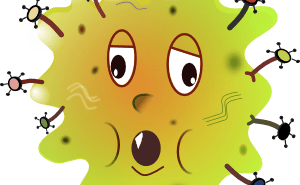Substituting ‘germs’ for ‘Romans’ the famous question from Monty Python “What have the Romans ever done for us?” produces what many will find a surprising answer:
Although ‘germs’, aka bacteria, have a very bad press and are mostly regarded as objects of disgust, causing disease and contaminating kitchen and bathroom surfaces, the majority of them are either benign or actively helpful. The sciences that study bacterial biodiversity are still struggling with the astonishing number of species, so far vastly outnumbering all the others on Earth. In biodiversity science, bacteria are ‘the elephant in the room’.
On-going research is revealing how dependent we are on bacteria, with new discoveries every week. Among the most recent and exciting of these concern the bacteria that reside in our own bodies. Somewhat disconcertingly, there are far more bacterial cells than human cells inside us and these make up the human microbiome. Recent evidence suggests that beneficial bacteria positively affect much of our development and physiology including, perhaps counter-intuitively, our immune system.
Bacteria underpin many ecosystem services, notably those that drive agriculture and forestry. For example, aerobic ammonia-oxidizing bacteria catalyze the oxidation of ammonia to nitrite and are therefore a crucial link in the global nitrogen cycle, generating soil fertility in natural ecosystems and agricultural production . Bearing this in mind, it is worth quoting Professor Tom Curtis (Nature Reviews Microbiology, 2006): “I make no apologies for putting microorganisms on a pedestal above all other living things, for if the last blue whale choked to death on the last panda, it would be disastrous but not the end of the world. But if we accidentally poisoned the last two species of ammonia-oxidisers, that would be another matter. It could be happening now and we wouldn’t even know…” One of the exciting fields of agricultural research is the inoculation of soils with beneficial bacteria, which, through natural growth, provide more permanent solutions to soil infertility rather than the temporary fix of industrial fertilizers.
Bacterial biodiversity also provides the basic resources for a range of industries. Consider, for example, the bacteria Leptospirillum and Ferroplasma , two remarkable genera that thrive on substrates containing precious or base metals. They metabolise the metal salts, sequestering the metal within their cells. The bacteria can then be flushed out of the system and the metals recovered. When the metals are in relatively high concentrations the process is called bio-mining, and when they are in low concentrations, often in wastes, the process is bio-remediation. Deinococcus (‘Conan the Bacterium’, Patrick Huyghe, The Sciences, July 1998) takes things a step further, being widely deployed to remediate radioactive waste sites. Still others consume oil spills.
Deinococcus belongs to a mega-diverse group of bacteria that naturally live in seemingly impossible habitats that may be very hot, cold, radioactive or under enormous pressure, known as extremophiles. They exemplify the natural resource value of bacterial biodiversity as they demonstrate the immensity of the genetic, metabolic and chemical variety already out there in nature. These bacterial resources generate many thousands of products with industrial and medical applications worth many billions of dollars annually worldwide. One of the most celebrated products was isolated from the bacterium Thermus aquaticus, an extremophile found in hot springs that evolved the heat-stable enzyme taq polymerase, which enabled a revolution in molecular biology, spawning a huge variety of biotech companies.
So, what have germs ever done for us? Well, on an individual level they regulate the development and physiology of our bodies while on a global level they underpin our food supply and provide the basic resources for many industries essential to human well-being.
This is just a very brief outline. For further reading, ‘Microbial Diversity and Bioprospecting by Alan T. Bull (editor) presents an overview of the multiple interactions between beneficial bacteria and the human economy.
MAHB-UTS Blogs are a joint venture between the University of Technology Sydney and the Millennium Alliance for Humanity and the Biosphere. Questions should be directed to joan@mahbonline.org
MAHB Blog: https://mahb.stanford.edu/blog/germs-and-us/
The views and opinions expressed through the MAHB Website are those of the contributing authors and do not necessarily reflect an official position of the MAHB. The MAHB aims to share a range of perspectives and welcomes the discussions that they prompt.
